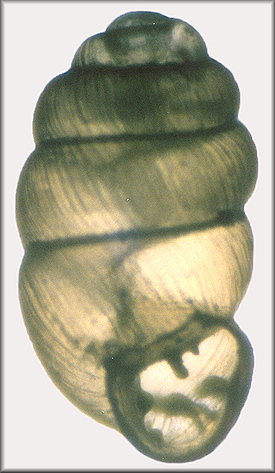Classification
Scientific Name: Vertigo paradoxa
Common Name: Mystery Vertigo
Domain: Eukarya
Kingdom: Animalia
Phylum: Mollusca
Class: Gastropoda
Order: Stylommatophora
Family: Pupillidae
Genus: Vertigo
Species: Vertigo paradoxa
Vertigo paradoxa Sterki, 1900 Pradox Vertigo
Eukarya: Vertigo paradoxa is under the Domain Eukarya because it
contains a true nucleus along with membrane bound
organelles (Encyclopedia of
Life, 2011).
Animalia: This organism is part of the Kingdom Animalia because it is
multicellular, heterotrophic, and ingests food and digests it in
an internal cavity. Vertigo paradoxa is also
placed in the Kingdom Animalia because its cells lack rigid cell
walls and the cells are organized into tissues
(Encyclopedia of Life, 2011).
Mollusca: Vertigo paradoxa is classified under the phylum Mollusca
because it has a soft body, a radula, and mantle which are
distinguishing characteristics of this phylum. This organism is
also bilaterally symmetrical and triploblastic
(Martin, 2000).
Gastropoda: This organism is classified under the class Gastropoda because
it possesses a muscular foot on the ventral side of its
body used for locomotion. This organism also goes through the
process of torsion, a 180° twist of its
visceral mass (Martin, 2000).
Stylommatophora: The order of this organism is Stylommatophora
because it has eyes found on
the tip of the taller pair of their two retractile tentacles
(Martin, 2000).
Pupillidae: Vertigo paradoxa is classified under the family Pupillidae
based on the arrangement of tiny lamellae, which are tooth like
structures, about the aperture of the shell
(Martin, 2000).
Vertigo: The genus of this organisms is Vertigo.
Members of this genus are characterized by having four to six lemallae that
protrude into the aperture. Their shell is oblong in shape and
usually translucent brown in color (Pearce et al.,
2004).
Vertigo paradoxa: This particular species
has a cinnamon-colored, and "beehive-shaped" shell
(Sterki, 2007). The aperture, the main opening of the shell, has four
lamellae, or "teeth"
(Sterki, 2007). A snail of this species
has a lower palatal lamella set deeper in the aperture than the
upper lamella above it. A basal lamella, bottom of the
aperture, is often absent (Pilsbry 1948 in Anderson 2004).
